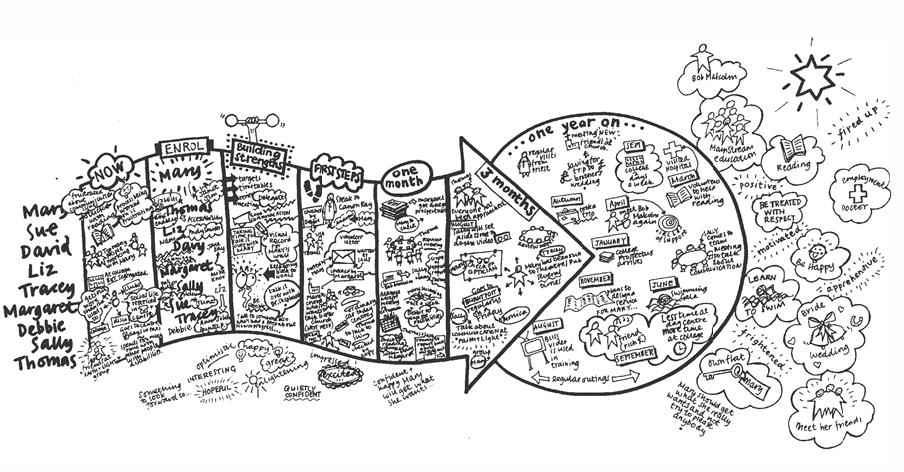PATHs to PossAbilities offers strategic organizational and life planning using person-centered tools to help individuals and businesses envision their desired future and translate this vision into a clear plan with defined action steps.
Your future begins with You!
~Person-Centered Planning~
Person-Centeredness
Person-Centered Practice is the alignment of service resources that give people access to the full benefits of community living and ensure they receive services in a way that may help them achieve individual goals.
Person-Centered Thinking helps to establish the means for a person to live a life that they, and the people who care about them, have good reasons to value.
Person-Centered Planning is a set of planning approaches designed to assist someone to build a positive life and supports … used most often as a life planning model to increase an individual’s personal self-determination and independence. It is a way to assist people to describe what they want, construct the lives they want and need to bring purpose and meaning to their life.
Characteristics of Person-Centered Practice
Community Participation & Presence – leading a fuller life through meaningful community activity & involvement, building meaningful relationships beyond family and service providers
Belonging - the human emotional need to be an accepted member of a group. Whether it is family, friends, co-workers, a religion, or something else, people tend to have an 'inherent' desire to belong and be an important part of something greater than themselves.
Choices and Rights - dignity and respect for one’s own choices; the Pathfinder “owns’ their future plan
Competence – a focus on a person’s strengths & being comfortable with obtaining assistance to build strengths
Contribution – the belief that each individual has strengths and skills that the larger community can benefit from
Why Person Centered thinking/ practices are So Important
For too long, the experiences, needs, desires and contributions of all persons with differnt abilities have been defined by segregated settings and limiting stereotypes.
All individuals have strengths, talents and skills that can be shared and utilized in their community, especially those who are differently-abled.
Minimizing paid support and increasing meaningful relationships is essential for one’s well-being.
How is Person-Centered Planning Different than Traditional Planning?
Traditional Planning: Traditional planning occurs within a program or institution and is focused on how the individual can benefit from the program services and what services the individual will receive. The planning process is usually controlled by the program or institution and the focus is on ameliorating the perceived deficits of the individual, finding special, segrated systems of support for the individual that are generally at a cost.
Person-Centered Planning: Person-Centered Planning occurs when an individual asks for support in seeking a fulfilling and positive life. It is a “whole individual” process that examines multiple areas of life, not just one. The planning process is controlled by the individual/their Support Circle and the focus is on building on the capacity, strengths and interests of the individual, and finding community opportunities, natural supports, real jobs and genuine friendships.
Who can Benefit from Person Centered Planning:
"Experts" and those Seeking Answers
High school students moving into Transition
Transition students moving to Adulthood
Adults looking to enrich their Life PATH
Adults looking for a Different Life PATH
Basically ... Any and Everyone!
Relevant for all Ages and all Populations
Adults, Adolescents and Children
Verbal and Non-Verbal Communicators
Introverts and Extraverts
Creative and Linear Thinkers
Professionals and Regular Folk
Person-centered Planning Outcomes:
The creation of or further enhancement of the future vision for an individual and their Circle of Support
The discovery of additional ways to successfully include the individual in their natural and preferred communities
An increase in the quality of life of the individual through choices and empowerment
examples of Person-centered Planning tools
The PATH (Planning Alternative Tomorrows with Hope, MAPs (Making Action Plans), PFP (Personal Futures Planning), Transition Planning, and ELP (Essential Lifestyle Planning)
PATH
Planning Alternative TOmorrows with Hope
MAPs
Making Action Plans
The PATH (Planning Alternative Tomorrows with Hope: PATH is a planning tool that has team members start by imagining and then detailing the future that the focus person aspires to. The team then works backward to what they consider should be the first steps towards achieving the future envisioned. It is a very results oriented process, excellent for team building, and has been used to mediate conflicts.
MAPs (Making Action Plans): MAPs is a planning tool that helps the focus person share thier personal history or life story based on personal milestones, and then after getting to know the focus person better and exploring his or her dreams, a team begins to build a plan that respects and honors the individual’s dreams.
PFP (Personal Futures Planning): PFP employs an on-going process in which planning teams replace system-centered methods with person-centered methods. This process is meant to encourage the focus person toward greater and greater self-determination, and those working with them, to create potential for the focus person to become an integral, contributing member of the community.
Transition Planning: Transition Planning is a planning process designed to hep individuals from 15 years and older, to plan for the transition to adult life, identifying the interests, needs and dreams of an individual and connecting them to community opportunities in the adult world that respects and honors their chosen lifestyle.
ELP (Essential Lifestyle Planning): ELP is a planning process designed to help an individual discover and attain what matters most to them and identify what supports might be needed. Discussions related to health and safety are an integral part of this process. The discoveries made during this guided process are described so that they are understood by all participants including the focus person and his or her family.


